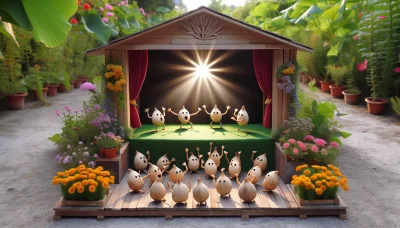Introduction to Garden Ponds Quiz
Test Your Knowledge
Question of
Introduction to Garden Ponds
Garden ponds are a beautiful and tranquil addition to any outdoor space, offering a unique blend of aesthetics, wildlife habitat, and ecological benefits. They can range from small container water gardens to large in-ground ponds, designed to fit the style and size of your garden. The appeal of garden ponds lies in their ability to create a peaceful retreat in your own backyard, attract a variety of wildlife such as birds, frogs, and beneficial insects, and offer an interesting and rewarding hobby for gardeners. With the right setup, garden ponds can also support aquatic plants and fish, adding vibrant life and color to your garden landscape.
Benefits of Having a Garden Pond
- Enhancing biodiversity
- Providing a habitat for wildlife
- Improving mental health
Planning Your Garden Pond
When it comes to creating a garden pond, planning cannot be overstated. It's the crucial first step that ensures the success and sustainability of your pond. The location of your pond will significantly affect its health and the variety of wildlife it can support. It should be placed in an area that receives ample sunlight and is away from trees to minimize debris. The size of your pond is another vital consideration; it should be proportionate to the size of your garden and accommodate your desired flora and fauna. Additionally, it's essential to be aware of any legal requirements in your area regarding water features. These might include permits or regulations on water usage and safety measures. By carefully considering these aspects, you can create a thriving ecosystem in your garden that brings joy for years to come.
Types of Garden Ponds
- Wildlife Ponds: Designed to attract and support local wildlife, these ponds often incorporate native plants and provide habitats for amphibians, insects, and birds.
- Fish Ponds: Specifically created to house fish, such as koi or goldfish, these ponds include features like deeper zones for fish to overwinter and systems to maintain clean water.
- Ornamental Ponds: Focused on aesthetic appeal, ornamental ponds often feature decorative elements like fountains, waterfalls, and ornate plantings.
Building Your Garden Pond
Constructing a garden pond is a rewarding project that enhances the beauty of your outdoor space. Here's a step-by-step guide to help you through the process:
- Plan Your Pond: Decide on the location, size, and shape. Consider sunlight exposure, proximity to trees (to avoid falling leaves), and access to electricity for pumps and filters.
- Mark the Area: Use rope or spray paint to outline the shape of your pond on the ground. This serves as a guide for excavation.
- Excavate the Pond: Dig the pond according to your plan. Depths can vary, but a depth of 18-24 inches is suitable for most garden ponds. Remember to slope the sides gently to create different depth zones.
- Install Underlay and Liner: Lay a protective underlay to safeguard your pond liner from punctures. Then, place the pond liner over the hole, ensuring it covers the entire area plus some extra for anchoring around the edges.
- Fill with Water: Slowly fill the pond with water. As it fills, adjust the liner to remove wrinkles and ensure it fits snugly against the pond's contours.
- Install Equipment: Set up any necessary equipment such as pumps, filters, and water features. Ensure they are correctly installed and functioning before proceeding.
- Add Rocks and Gravel: Place rocks around the edge to secure the liner and add gravel to the bottom to create a natural look. This also provides a surface for beneficial bacteria to colonize.
- Introduce Plants: Add a variety of aquatic plants to your pond. Include oxygenators to improve water quality, floating plants to provide shade, and marginal plants around the edges.
- Introduce Wildlife: If desired, you can introduce fish to your pond. Ensure the pond has been functioning for a few weeks and that the water quality is suitable before adding any fish.
With patience and care, your garden pond will soon become a thriving ecosystem and a peaceful retreat in your backyard. Remember to maintain it regularly to keep it looking its best.
Maintaining Your Garden Pond
| Season | Maintenance Task | Details |
|---|---|---|
| Spring | Cleaning | Remove debris and dead plants, clean filters and pumps. |
| Spring | Water Quality Testing | Test for pH, ammonia, nitrite, and nitrate levels. |
| Spring | Plant Care | Divide and repot aquatic plants, remove winter protective coverings. |
| Summer | Algae Control | Monitor and manage algae growth, possibly using UV clarifiers or algaecides. |
| Summer | Water Level Monitoring | Top off water levels due to evaporation, ensure proper operation of pumps and waterfalls. |
| Fall | Prepare for Winter | Remove fallen leaves, add cold water bacteria, trim back plants. |
| Winter | Ice Management | Ensure a portion of the pond remains ice-free to allow gas exchange for fish. |
| Winter | Equipment Care | Remove and store pumps and filters, if applicable, or ensure they are suitable for winter operation. |












